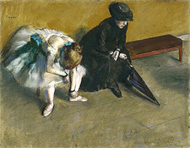 |
 |
 |
Grades/Level: Middle School (6–8), High School (9–12)
Subjects: Visual Arts, English–Language Arts
Time Required: Short Activity
20–30 minutes
Author: J. Paul Getty Museum Education Staff
|
 |
 |
 |
 |
 |
Activity Overview |
This activity prepares students for the Guided Lesson at the Getty Center, Exploring Art Through Writing. In this lesson, students will use writing activities as a way to engage with works of art. Two writing exercises focused on a work of art—descrptive writing and creative writing—are designed to help students slow down, look carefully, and think about what they see. |
 |
 |
 |
Learning Objectives |
Students should be able to:
• look closely at, and think creatively about works of art.
• use observational and language skills to write a descriptive paragraph about a work of art.
• make personal connections to a visual image in a creative writing exercise. |
 |
 |
 |
 |
 |
Materials |
• Image of Sunrise (Marine) by Claude Monet
• Image of Waiting: Dancer and Woman with Umbrella by Edgar Degas
• Image of A Walk at Dusk by Caspar Friedrich |
 |
 |
 |
|
|
 |
 |
Activity Steps |
Step 1: Before displaying the images, ask students to think about what a person can learn by looking at art. Make a list of their responses. Discuss their ideas as a group.
Step 2: Display the images of the three works of art above for your students:
• Claude Monet, Sunrise
• Edgar Degas, Waiting: Dancer and Woman with Umbrella
• Caspar David Friedrich, A Walk at Dusk
Tell your students that they are going to select one of the three images and will use it to do two writing activities. Before they choose, ask the students to spend a quiet minute just looking closely at all three images together. Explain that these are reproductions of original works of art and that the originals are in the Getty Museum's collection.
Step 3: Ask your students to select an image. Have the students that selected the same print sit together so that they can observe the image closely as a small group. Give the instructions for the writing activities. The time you allow for the assignments depends on your class. Each could be done in approximately 5 to 20 minutes.
Activity #1: Descriptive Writing
Instructions for students:
Write an objective description of the picture that is so detailed that a person who has never seen it could draw it from your description. Start by making a list of the details that describe its appearance. Limit the list to the physical aspects of the painting. Avoid using judgmental language that makes assumptions about what is happening in the scene.
After the activity:
Have students share their descriptions together as a class. Discuss any judgmental language that might have slipped into the descriptions, explaining that the focus here is on just the facts. Ask the students to decide which descriptions they think are the most effective and why. Ask them what these descriptions leave out, what are they missing? What are the descriptions effective at communicating?
Activity #2: Creative Writing
Instructions for students:
Using your descriptions as a starting point, create a story based on what you see in the image beginning with the phrase, “Last night I had the strangest dream...” In describing your dream, include what you saw, heard, felt, sensed, and experienced.
After the activity:
Debrief as a group. Ask your students to compare how they experienced the images in each activity. How was the act of looking and writing the same or different? Which activity did they prefer? What advantages could each writing activity have?
Step 4: Share some of the background information provided in the packet about each image that you think would be relevant for your students. As a group, discuss how knowing more details about the artwork and artist changes, or adds to, their previous understanding. |
 |
 |
 |
| Waiting: Dancer and Woman with Umbrella, Edgar Germain Hilaire Degas, about 1882 |
 |
|
 |
 |
 |
Standards Addressed |
The following content standards will be covered in your Guided Lesson at the Getty Center.
English—Language Arts Content Standards for California Public Schools
Grades 7—12
Writing
2.0 Writing Applications
Students write narrative, expository, persuasive, and descriptive texts.
Listening and Speaking
1.0 Listening and Speaking Strategies
Deliver focused, coherent presentations that convey ideas clearly. Students evaluate the content of oral communication.
Visual Arts Content Standards for California Public Schools
Grades 7–12
Artistic Perception
1.0 Processing, Analyzing, and Responding to Sensory Information through the Language and
Skills Unique to the Visual Arts
Students perceive and respond to works of art, objects in nature, events, and the environment. They also use the vocabulary of the visual arts to express their observations.
Historical and Cultural Context
3.0 Understanding the Historical Contributions and Cultural Dimensions to the Visuals Arts
Students analyze the role and development of the visuals arts in past and present cultures throughout the world, noting human diversity as it relates to the visual arts and artists.
Aesthetic Valuing
4.0 Responding to, Analyzing, and Making Judgments about Works in the Visual Arts
Students analyze, assess, and derive meaning from works of art, including their own, according to the elements of art, the principles of design, and aesthetic qualities. |
 |

|
 |



